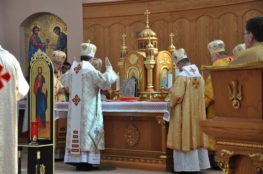Strange I never saw it before, but a friend directed me to an apparently defunct blog, The Holy Unia. The title pretty much gives away the game in terms of its orientation and, to be frank, much of the content isn’t terribly inspiring. Although the blog disclaims any affiliation with the Society of St. Pius X or its eastern affiliate, the Society of Josaphat, the tone is similar—which is fine. What’s less fine, or at least less clear, is what, if anything, is to be made of the site’s “mission.” It seems that there is still an inclination on the part of some to see “Uniatism,” that is, the incremental reunification of Eastern churches through the establishment of parallel sees, as the only acceptable model of bringing Catholicism and Orthodoxy (Eastern or Oriental) together. That hasn’t exactly been the way of things for some time now. No, the Balamand Statement does not carry much (or any) magisterial heft for Catholics, but as a “policy paper” it effectively put an end to “Uniatism.” So what then is the next step? If one follows the line proposed by Fr. Robert Taft to its logical conclusion, it would seem that what the Catholic Church “should do” is simply recognize the Orthodox Church as a true, particular church; offer full reciprocal communion to any local Orthodox church that will accept it; and lay aside almost every substantive theological disagreement the two parties have (or at least think they have). It’s a radical vision, and not one likely to come into being any time soon. Not only are most local Orthodox churches unlikely to accept such an offer, but Roman chauvinism isn’t dead—just ask the Eastern Catholics.
Now, it’s not clear what Balamand means to the Orthodox, just as its usually not clear what the Orthodox, a whole, think about much of anything. That remains one of Orthodoxy’s great weaknesses, albeit one the Orthodox themselves rarely wish to acknowledge. The failure (some might say the inability) for the East to establish what Fr. Taft has called “Self-Critical Orthodoxy” may, in certain parts of the world, be changing, but the pace is incredibly slow. Attempts during the last century to peel back some of the layers of history which had accumulated on the Eastern deposit of faith caused more than a small amount of controversy. Even today, here in the (geographic) West, there remains considerable resistance among certain Orthodox bishops, priests, and laity to see Orthodoxy as much more than a fundamentalist-style faith, accompanied with the usual silly ornaments, like anti-intellectualism fueled by a fever-swamp mentality. The Roman Catholic Church has more than a few of those types as well—and not just the sedevacantists.
Returning to the question of “Uniatism,” it does seem that if Catholics and Orthodox are ever going to find unity, it will have to be a unity built from the bottom up. Academic conferences, official visits, and high-level dialogues are all well and good, but until Catholics and Orthodox can come to a ground-level (and sympathetic!) understanding of one another, then all of the top-tier talk will amount to little more than self-important claptrap. In the (geographic) West there is an unusual opportunity for Catholics, particularly Roman Catholics, to engage with the Orthodox in a charitable manner and vice versa. What’s depressing is how seldom those opportunities are acted upon. It is seldom enough that Roman Catholics spend five minutes in a Greek Catholic parish. Expecting them to go the extra mile with the Orthodox must seem like rank foolishness.
The Orthodox don’t have clean hands either, and too many would rather go on about how there is no grace in the Catholic Church than try to understand Roman positions which they claim are “heretical.” The sad thing—the tragic thing—is that Catholics and Orthodox need each other now more than ever. Pride, the great sin of Satan that is repeated again and again by every soul on earth, regardless of their confessional position, keeps at bay all possibilities for reconciliation. Such pride no doubt leads many to wonder how either side of the divide can regard itself as “holy.”



